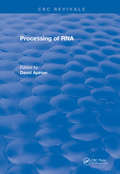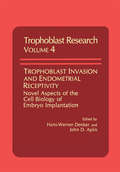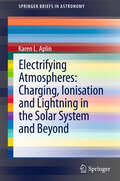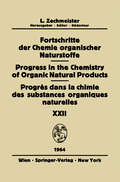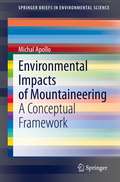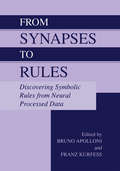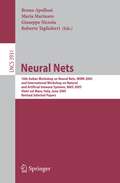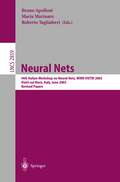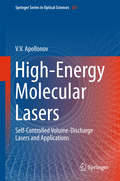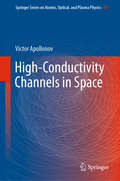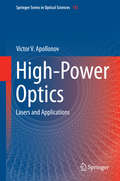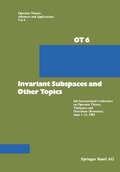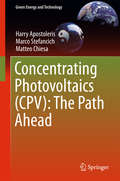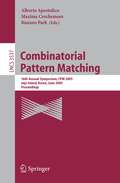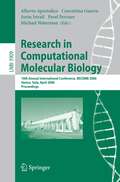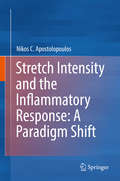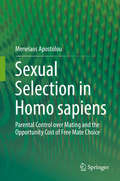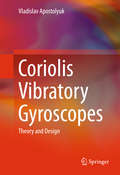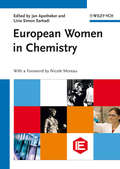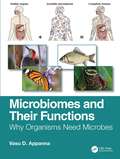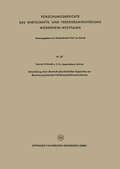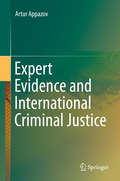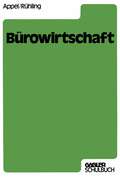- Table View
- List View
Processing of RNA (CRC Press Revivals)
by David ApirionIn a fast-moving field it is unlikely that articles written more than a year ago would be completely up to date. The purpose of this book is to bring to the nonspecialist an overall view as well as an update on the state of the art as it existed in the beginning of 1982, and to the specialist the opportunity to have a single source of information for how the other organisms do it, and also to enable him to find out the status of the various aspects of RNA processing with which he might not be to familiar. even if only some of these goals are achieved, all those who labored so diligently to bring about the publication of this book would be more than gratified.
Trophoblast Invasion and Endometrial Receptivity: Novel Aspects of the Cell Biology of Embryo Implantation (Trophoblast Research #4)
by John D. Aplin Hans-Werner DenkerInterest in mechanisms of embryo implantation is increasing, particularly with the realization that failure of implantation after in vitro fertilization and embryo transfer places significant limits on the success of treatment. In addition, there is a need to provide hypotheses, and ultimately mechanisms, for the high rates of embryonic loss in women in the population at large. Traditionally, implantation research has concentrated on genetics and endocrinology without providing many therapeutic benefits. A new era is now beginning with the application of modem cellular and molecular approaches to the investigation of the relationship between trophoblast and endometrium. At the same time, older data can be reevaluated in the light of current research into cell cell and cell-matrix interactions. The feeling that new avenues of research are open was apparent when an international group of scientists came together at a workshop on "The Cell Biology of Trophoblast Invasion In Vivo and In Vitro" held during the XXIV Annual Meeting of the Cell, Tissue and Organ Culture Study Group (C.T.O.C.) at Heidelberg in 1986. What was unusual about this Conference was the interdisciplinary dialogue between implantation researchers and tumor biologists, highlighting aspects common to invasion of trophoblast and tumor cells.
Electrifying Atmospheres: Charging, Ionisation and Lightning in the Solar System and Beyond (SpringerBriefs in Astronomy)
by Karen AplinElectrical processes take place in all planetary atmospheres. There is evidence for lightning on Venus, Jupiter, Saturn, Uranus and Neptune, it is possible on Mars and Titan, and cosmic rays ionise every atmosphere, leading to charged droplets and particles. Controversy surrounds the role of atmospheric electricity in physical climate processes on Earth; here, a comparative approach is employed to review the role of electrification in the atmospheres of other planets and their moons. This book reviews the theory, and, where available, measurements, of planetary atmospheric electricity, taken to include ion production and ion-aerosol interactions. The conditions necessary for a global atmospheric electric circuit similar to Earth’s, and the likelihood of meeting these conditions in other planetary atmospheres, are briefly discussed. Atmospheric electrification is more important at planets receiving little solar radiation, increasing the relative significance of electrical forces. Nucleation onto atmospheric ions has been predicted to affect the evolution and lifetime of haze layers on Titan, Neptune and Triton. For planets closer to Earth, heating from solar radiation dominates atmospheric circulations. Mars may have a global circuit analogous to the terrestrial model, but based on electrical discharges from dust storms, and Titan may have a similar global circuit, based on transfer of charged raindrops. There is an increasing need for direct measurements of planetary atmospheric electrification, in particular on Mars, to assess the risk for future unmanned and manned missions. Theoretical understanding could be increased by cross-disciplinary work to modify and update models and parameterisations initially developed for a specific atmosphere, to make them more broadly applicable to other planetary atmospheres. The possibility of electrical processes in the atmospheres of exoplanets is also discussed.
Fortschritte der Chemie Organischer Naturstoffe / Progress in the Chemistry of Organic Natural Products / Progrès dans la Chimie des Substances Organiques Naturelles (Fortschritte der Chemie organischer Naturstoffe Progress in the Chemistry of Organic Natural Products #22)
by R. T. Aplin G. Billek J. F. Grove T. G. Halsall W. Keller-Schierlein V. Prelog K. Schaffner P. J. Scheuer H. ZähnerEnvironmental Impacts of Mountaineering: A Conceptual Framework (SpringerBriefs in Environmental Science)
by Michal ApolloThis book investigates the consequences of mountaineering (hiking, trekking, climbing) on the natural environment. These consequences are divided into three groups: 1) transformations caused by the mountaineer’s, or other people’s, stay in a mountaineering region; 2) transformations caused by the mountaineer’s travel (movement) through a mountaineering region, with the consideration of the ground type (rock, rock and grass, grass, residual soil, snow, ice), and 3) transformations caused by the use of mountaineering equipment. Each of the three groups are examined individually for their direct interference with the environment, i.e. caused by the main activities of climbing, trekking and hiking (both for elite and mass mountaineering) and their indirect interference caused by auxiliary activity (mainly in the case of mass mountaineering). Auxiliary activity includes guide services, transport of equipment, use of base camp facilities and the delivery of artificial support equipment, and supports the main activity. The consequences of mountaineering on the natural environment are characterized in terms of individual components of the environment (land relief, soil, vegetation, fauna, and landscape) and location/zone of mountaineering activity (hiking, trekking or climbing zone). Because of the connections and interdependence between particular components of the environment (biotic and abiotic), only preservation of each of them can bring the desired effect – a reduction in the negative impact of mountaineering. This book presents comprehensive research outcomes and serves as a platform for more detailed, future studies.
From Synapses to Rules: Discovering Symbolic Rules from Neural Processed Data
by Bruno Apolloni Franz KurfessOne high-level ability of the human brain is to understand what it has learned. This seems to be the crucial advantage in comparison to the brain activity of other primates. At present we are technologically almost ready to artificially reproduce human brain tissue, but we still do not fully understand the information processing and the related biological mechanisms underlying this ability. Thus an electronic clone of the human brain is still far from being realizable. At the same time, around twenty years after the revival of the connectionist paradigm, we are not yet satisfied with the typical subsymbolic attitude of devices like neural networks: we can make them learn to solve even difficult problems, but without a clear explanation of why a solution works. Indeed, to widely use these devices in a reliable and non elementary way we need formal and understandable expressions of the learnt functions. of being tested, manipulated and composed with These must be susceptible other similar expressions to build more structured functions as a solution of complex problems via the usual deductive methods of the Artificial Intelligence. Many effort have been steered in this directions in the last years, constructing artificial hybrid systems where a cooperation between the sub symbolic processing of the neural networks merges in various modes with symbolic algorithms. In parallel, neurobiology research keeps on supplying more and more detailed explanations of the low-level phenomena responsible for mental processes.
Neural Nets: 16th Italian Workshop on Neural Nets, WIRN 2005, International Workshop on Natural and Artificial Immune Systems, NAIS 2005, Vietri sul Mare, Italy, June 8-11, 2005, Revised Selected Papers (Lecture Notes in Computer Science #3931)
by Bruno Apolloni Maria Marinaro Giuseppe Nicosia Roberto TagliaferriThis book constitutes the thoroughly refereed postproceedings of the 16th Italian Workshop on Neural Nets, WIRN 2005, as well as the satellite International Workshop on Natural and Artificial Immune Systems, NAIS 2005, held in Vietri sul Mare, Italy in June 2005. The 41 revised papers presented together with a lecture by the winner of the Premio Caianiello award were carefully reviewed and improved during two rounds of selection and refereeing.
Neural Nets: 14th Italian Workshop on Neural Nets, WIRN VIETRI 2003, Vietri sul Mare, Italy, June 4-7, 2003, Revised Papers (Lecture Notes in Computer Science #2859)
by Bruno Apolloni Maria Marinaro Roberto TagliaferriHigh-Energy Molecular Lasers: Self-Controlled Volume-Discharge Lasers and Applications (Springer Series in Optical Sciences #201)
by V. V. ApollonovThis book displays the physics and design of high-power molecular lasers. The lasers described are self-controlled volume-discharge lasers. The book explains self-sustained discharge lasers, self-initiated discharge lasers and technical approaches to laser design. Important topics discussed are laser efficiency, laser beam quality and electric field homogeneity. The book contains many new innovative applications.
High-Conductivity Channels in Space (Springer Series on Atomic, Optical, and Plasma Physics #103)
by Victor ApollonovThis book discusses the physics of conductive channel development in space, air and vacuums and summarizes the attempts to create super-long conductive channels to study the upper atmosphere and to complete specific tasks related to energy transmission from the space to earth with high-voltage high repetition rate electrical sources. Conductive channels are produced by the laser jet engine vehicle-propulsion under the influence of powerful high repetition rate pulse-periodic laser radiation by CO2-laser, solid state Nd YAG,HF/DF laser systems generated with each pulse of the powerful laser conductive dust plasma. The book also presents the experimental and theoretical results of conductive canal modeling: the laser jet engine vehicle “Impulsar”, which can reach the lower layers of the ionosphere in several hundred seconds. Further, the book explores the development of lightning protection systems. The so-called long laser spark is generated to provide the conditions for connecting a thunderstorm cloud with a grounded metal rod, i.e. a classical lightning rod. Such conductivity channels can be used for energy transmission, overvoltage protection systems, transport of charged particle beams and plasma antennas. It provides the theoretical and experimental basis of high repetition rate P-P mode of operation for high power lasers (COIL, HF/DF, CO2,Nd YAG). It describes high efficiency and excellent beam quality disk lasers used for numerous applications, including surface treatment of dielectric materials in microelectronics, cutting, drilling, welding, polishing and cleaning of the surface and other technological operations. Lastly it investigates how megawatt mono-module disk lasers could be used to solve various problems: small satellites launched by lasers, formation of super-long conducting channels in space and atmosphere, cleaning of the near-earth space from the space debris and related applications.
High-Power Optics: Lasers and Applications (Springer Series in Optical Sciences #192)
by Victor V. ApollonovThis book covers the basics, realization and materials for high power laser systems and high power radiation interaction with matter. The physical and technical fundamentals of high intensity laser optics and adaptive optics and the related physical processes in high intensity laser systems are explained. A main question discussed is: What is power optics? In what way is it different from ordinary optics widely used in cameras, motion-picture projectors, i.e., for everyday use? An undesirable consequence of the thermal deformation of optical elements and surfaces was discovered during studies of the interaction with powerful incident laser radiation. The requirements to the fabrication, performance and quality of optical elements employed within systems for most practical applications are also covered. The high-power laser performance is generally governed by the following: (i) the absorption of incident optical radiation (governed primarily by various absorption mechanisms), (ii) followed by a temperature increase and response governed primarily by thermal properties and (iii) the thermo-optical and thermo-mechanical response of distortion, stress, fracture, etc. All this needs to be understood to design efficient, compact, reliable and useful high power systems for many applications under a variety of operating conditions, pulsed, continuous wave and burst mode of varying duty cycles. The book gives an overview of an important spectrum of related topics like laser resonator configurations, intermetallic optical coatings, heat carriers for high power optics, cellular materials, high-repetition-rate lasers and mono-module disk lasers for high power optics.
Invariant Subspaces and Other Topics: 6th International Conference on Operator Theory, Timişoara and Herculane (Romania), June 1–11, 1981 (Operator Theory: Advances and Applications #6)
by Apostol Douglas Nagy VoisulescuThe annual Operator Theory conferences in Timigoara are conceived as a means to promote cooperation and exchange of in formation between specialists in all areas of Operator Theory. The present volume consist of papers contributed by the partici pants of the 1981 Conference. Since many of these papers contain results on the invariant subspace problem or are related to the role of invariant subspaces in the study of operators or operator systems, we thought it appropiate to mention this in the title of the volume, though the "other topics" have a wide range. As in past years, special sessions concerning other fields of Functio nal Analysis were organized at the 1981 Conference, but contri butions to these sessions are not included in the present volume. The research contracts of the Department of Mathematics of INCREST with the National Council for Sciences and Technology of Romaliia provided the means for developping the research activity in Functional Analysis; these contracts constitute the generous framework for these meetings. We want also to acknowledge the support of INCREST and the excelent organizing job done by our host - University of Timigoa ra-. Professor Dumitru Gagpar and Professor Mircea Reghig are among those people in Timigoara who contributed in an essential way to the success of the meeting.
Concentrating Photovoltaics (Green Energy and Technology)
by Harry Apostoleris Marco Stefancich Matteo ChiesaThis book is a concise review of the current status and future prospects of concentrating photovoltaic (CPV) technology. Starting with a summary of the current technical and economic status of CPV technology, it identifies the factors that hold CPV back in the commercial market. The main technical areas considered are solar cells, tracking and optics. The solar cells section focuses on spectrum splitting systems, which offer potentially higher efficiency than multi-junction cells with reductions in the manufacturing constraints that lead to high costs. It also offers a brief survey of the latest developments in spectral splitting alongside a discussion of the advances in solar cell manufacturing that aid the development of such systems. Further, it examines electrical design principles for spectral splitting systems that can improve the spectral stability of these systems’ performance. The section on tracking includes a description of tracking integration with an update of the review published in Nature, presenting the latest advances in the field and focusing on surveying conceptual approaches rather than providing an exhaustive description of the literature. The optics section explores 3D printing and other emerging methods of fabricating optics for both prototype and large-scale production, as well as new classes of concentrators, particularly those based on novel photonic materials such as angular filters. Lastly, the authors consider the impact that environmental factors have on the performance of CPV in non-standard environments before concluding with a discussion of the combinations of technologies that they anticipate will most effectively boost CPV in the commercial market.
Combinatorial Pattern Matching: 16th Annual Symposium, CPM 2005, Jeju Island, Korea, June 19-22, 2005, Proceedings (Lecture Notes in Computer Science #3537)
by Alberto Apostolico Maxime Crochemore Kunsoo ParkResearch in Computational Molecular Biology: 10th Annual International Conference, RECOMB 2006, Venice, Italy, April 2-5, 2006, Proceedings (Lecture Notes in Computer Science #3909)
by Alberto Apostolico Concettina Guerra Sorin Istrail Pavel Pevzner Michael WatermanStretch Intensity and the Inflammatory Response: A Paradigm Shift
by Nikos C. ApostolopoulosIn this manuscript, practitioners and students who are concerned with sports and rehabilitation medicine, kinesiology, as well as coaches and athletes, are introduced to numerous concepts, including mechanotransduction, inflammation, pro- and anti-inflammatory cytokines, calpains, the extracellular matrix, neutrophils and macrophages, and their relevance to stretching, particularly stretching intensity. Although the quantitative parameters of training, duration, and frequency are important, it is the qualitative criterion of intensity (“how much”) that the author suggests is ultimately of greater concern. Intensity, the rate and magnitude of force, may be responsible for the proper recovery, regeneration, and adaptation of the musculoskeletal tissues from training, competition, or rehabilitation from injuries. Research suggests that too much force results in the stimulation of an inflammatory response, one associated with a biochemical feedback emerging from a mechanical stimulus. The intent of this manuscript is twofold: to initiate the discussion of the importance of stretching intensity with regard to proper recovery, regeneration, and adaptation, and to suggest that researchers need to explore its potential role in addressing numerous inflammatory (RA) and non-inflammatory (OA, recurrent tendinitis etc.) musculoskeletal conditions as well.
Sexual Selection in Homo sapiens: Parental Control over Mating and the Opportunity Cost of Free Mate Choice
by Menelaos ApostolouThe present book aims to examine how sexual selection works in the human species. Almost all scholarly effort focuses on sexual selection in non-human species and extrapolates the findings to the human one. However, human mating has a unique pattern not found in any other species, namely parental influence over mate choice. Across preindustrial societies, the typical pattern of long-term mating is arranged marriage, where parents choose spouses for their children. By doing so, parents effectively become a sexual selection force. Traits that enhance an individual’s chance to be selected as a son- or a daughter-in-law confer important reproductive advantages to those who are endowed with them, increasing in frequency in the population. The author has coined the term parental choice to describe the sexual selection force that arises from parental control over mating. He synthesizes extensive theoretical and empirical work in order to understand and model this force. The aim is to understand which factors give rise to parental choice and to combine these insights into constructing a more formal model. It also aims to further examine whether the predictions of the model fit the patterns of mating found across different types of human societies, and how the model can be used to understand the evolution of behavioral traits involved in mating. By synthesizing the various arguments put forward and published across the literature, the book offers a comprehensive argument and overview of an aspect of sexual selection unique to our species. Furthermore, the book revises and extends previously made arguments and models, while it provides useful insights on how the proposed revision of sexual selection theory can enable us to understand a wide range of human behavioral phenomena. It should be key reading for those interested in studying sexual selection in general and in the Homo sapiens species in particular.
Coriolis Vibratory Gyroscopes: Theory and Design
by Vladislav ApostolyukThis book provides the latest theoretical analysis and design methodologies of different types of Coriolis vibratory gyroscopes (CVG). Together, the chapters analyze different types of sensitive element designs and their kinematics, derivation of motion equations, analysis of sensitive elements dynamics in modulated and demodulated signals, calculation and optimization of main performance characteristics, and signal processing and control. Essential aspects of numerical simulation of CVG using Simulink® are also covered. This is an ideal book for graduate students, researchers, and engineers working in fields that require gyroscope application, including but not limited to: inertial sensors and systems, automotive and consumer electronics, small unmanned aircraft control systems, personal mobile navigation systems and related software development, and augmented and virtual reality systems.
European Women in Chemistry
by Jan Apotheker Livia Simon Sarkadi"I have no dress except the one I wear every day. If you are going to be kind enough to give me one, please let it be practical and dark so that I can put it on afterwards to go to the laboratory", said Marie Curie about her wedding dress. According to her lecture notes, Gertrude B. Elion is quoted a few decades later: "Don't be afraid of hard work. Don't let others discourage you, or tell you that you can't do it. In my day I was told women didn't go into chemistry. I saw no reason why we couldn't." These two quotations from famous, Nobel Prize winning chemists amply demonstrate the challenges that female scientists in the past centuries have had to overcome; challenges that are still sometimes faced by the current generation. They "must have the noblest courage, quite extraordinary talents and superior genius" wrote Carl Friedrich Gauss 1807 in a letter to mathematician Sophie Germain. For the official book to celebrate the International Year of Chemistry, the European Association for Chemical and Molecular Sciences (EuCheMS) has chosen one of the central goals of the International Year: the contribution and role of women in chemistry. This celebration, which is the focus of European Women in Chemistry, takes us on a journey through centuries of chemical research, focusing on the lives of those amazing women from ancient times to the current day who dared to study this subject, often against advice or societal expectations. These portraits emphasize the extraordinary path and personality of these fascinating women, their major contribution to chemistry, but all in the context of their time and social environment. Some of these women, like Marie Curie and Dorothy Crowfoot Hodgkin, are famous and still well-known today. Others have contributed significantly to the development of science and lived an exceptional life, but are nowadays almost forgotten. This book is a tribute to all of them and a motivation for new generations to come to tread new paths, fight for unusual ideas and control one?s own destiny.
European Women in Chemistry
by Jan Apotheker Livia Simon Sarkadi Nicole J. Moreau"I have no dress except the one I wear every day. If you are going to be kind enough to give me one, please let it be practical and dark so that I can put it on afterwards to go to the laboratory", said Marie Curie about her wedding dress. According to her lecture notes, Gertrude B. Elion is quoted a few decades later: "Don't be afraid of hard work. Don't let others discourage you, or tell you that you can't do it. In my day I was told women didn't go into chemistry. I saw no reason why we couldn't." These two quotations from famous, Nobel Prize winning chemists amply demonstrate the challenges that female scientists in the past centuries have had to overcome; challenges that are still sometimes faced by the current generation. They "must have the noblest courage, quite extraordinary talents and superior genius" wrote Carl Friedrich Gauss 1807 in a letter to mathematician Sophie Germain. For the official book to celebrate the International Year of Chemistry, the European Association for Chemical and Molecular Sciences (EuCheMS) has chosen one of the central goals of the International Year: the contribution and role of women in chemistry. This celebration, which is the focus of European Women in Chemistry, takes us on a journey through centuries of chemical research, focusing on the lives of those amazing women from ancient times to the current day who dared to study this subject, often against advice or societal expectations. These portraits emphasize the extraordinary path and personality of these fascinating women, their major contribution to chemistry, but all in the context of their time and social environment. Some of these women, like Marie Curie and Dorothy Crowfoot Hodgkin, are famous and still well-known today. Others have contributed significantly to the development of science and lived an exceptional life, but are nowadays almost forgotten. This book is a tribute to all of them and a motivation for new generations to come to tread new paths, fight for unusual ideas and control one?s own destiny.
Microbiomes and Their Functions: Why Organisms Need Microbes
by Vasu D. AppannaThis book provides a fundamental understanding of the importance of the microbiome in the life of virtually all multicellular organisms. It explains why microbes are an integral part of living organisms and describes the diverse roles they perform for their hosts. Although the significance of modified bacteria such as the mitochondrion and chloroplast is deeply rooted in the evolution of all complex organisms, it is only recently that the contribution of microbial partners within and on their hosts is becoming fully evident. These communities of microbes are as essential to organisms as are the visible organs. Microbiomes are indeed “invisible organs.” They participate in the digestive process, assist in communication networks, supply essential nutrients, guard against foreign intrusion, promote development and contribute to well-being. This unique approach, where the dependence of the hosts on their microbiomes is explained, will be a must-read for undergraduate and graduate students. Researchers and professionals probing microbial interactions with living organisms will find this book interesting and enriching. Key Features · Emphasizes the roles microbiomes play within their hosts. · Includes many captivating illustrations enabling easy comprehension. · Explains microbiome functions from algae to vertebrates. · Reveals how microbiomes contribute to the health of the hosts and the ecosystems. · Describes the impact of dysbiosis on diseases, food security and climate change. · Boxed sections provide a detailed analysis of concepts and are accompanied by vivid illustrations.
Microbiomes and Their Functions: Why Organisms Need Microbes
by Vasu D. AppannaThis book provides a fundamental understanding of the importance of the microbiome in the life of virtually all multicellular organisms. It explains why microbes are an integral part of living organisms and describes the diverse roles they perform for their hosts. Although the significance of modified bacteria such as the mitochondrion and chloroplast is deeply rooted in the evolution of all complex organisms, it is only recently that the contribution of microbial partners within and on their hosts is becoming fully evident. These communities of microbes are as essential to organisms as are the visible organs. Microbiomes are indeed “invisible organs.” They participate in the digestive process, assist in communication networks, supply essential nutrients, guard against foreign intrusion, promote development and contribute to well-being. This unique approach, where the dependence of the hosts on their microbiomes is explained, will be a must-read for undergraduate and graduate students. Researchers and professionals probing microbial interactions with living organisms will find this book interesting and enriching. Key Features · Emphasizes the roles microbiomes play within their hosts. · Includes many captivating illustrations enabling easy comprehension. · Explains microbiome functions from algae to vertebrates. · Reveals how microbiomes contribute to the health of the hosts and the ecosystems. · Describes the impact of dysbiosis on diseases, food security and climate change. · Boxed sections provide a detailed analysis of concepts and are accompanied by vivid illustrations.
Entwicklung einer chemisch-physikalischen Apparatur zur Bestimmung kleinster Kohlenoxyd-Konzentrationen (Forschungsberichte des Wirtschafts- und Verkehrsministeriums Nordrhein-Westfalen #67)
by Heinrich Wösthoff ApparatebauExpert Evidence and International Criminal Justice
by Artur AppazovThe book is a comprehensive narration of the use of expertise in international criminal trials offering reflection on standards concerning the quality and presentation of expert evidence. It analyzes and critiques the rules governing expert evidence in international criminal trials and the strategies employed by counsel and courts relying upon expert evidence and challenges that courts face determining its reliability. In particular, the author considers how the procedural and evidentiary architecture of international criminal courts and tribunals influences the courts’ ability to meaningfully incorporate expert evidence into the rational fact-finding process. The book provides analysis of the unique properties of expert evidence as compared with other forms of evidence and the challenges that these properties present for fact-finding in international criminal trials. It draws conclusions about the extent to which particularized evidentiary rules for expert evidence in international criminal trials is wanting. Based on comparative analyses of relevant national practices, the book proposes procedural improvements to address some of the challenges associated with the use of expertise in international criminal trials.
